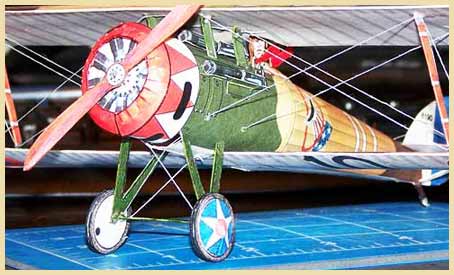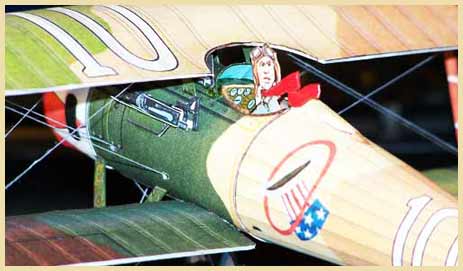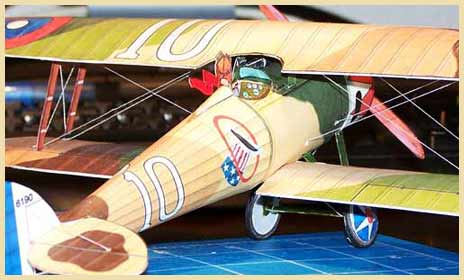


Nieuport 28 - $$5.50
The Nieuport 28 is unique in aviation history having received considerable fame for being a glorious fighting machine when in truth, it was rejected as a frontline fighter by the French Airservice. Because of ready availability it was rushed into production even without customers and was supplied to the American Expeditionary Air Force early in 1918. 2/7-12
Nieuport-28 WWI
Scout- Eddie Rickenbacker's Hat in the Ring
Click HERE to get to the Nieuport 28 Collection model offer (the pages will be similar)
 The Nieuport 28 is unique in aviation history having received considerable
fame for being a glorious fighting machine when in truth, it was
rejected as a frontline fighter by the French Air service. Because
of ready availability it was rushed into production even without
customers and was supplied to the American Expeditionary Air Force
early in 1918 being the first to carry to carry the U.S. colors
into combat- even if it was only for the last two months of WWI
!!
The Nieuport 28 is unique in aviation history having received considerable
fame for being a glorious fighting machine when in truth, it was
rejected as a frontline fighter by the French Air service. Because
of ready availability it was rushed into production even without
customers and was supplied to the American Expeditionary Air Force
early in 1918 being the first to carry to carry the U.S. colors
into combat- even if it was only for the last two months of WWI
!!
Similar to it's predecessors, the Nieuport 28 had a wire-braced, four-longeron wooden fuselage with fabric covering, and wooden framed wings and empennage, with an aluminum tube under-carriage. The tail surfaces were exactly the same as the Nieuport 23, 24, and the 27. Note-worthy was Gustave Delage's radical break with his previous successful design formula when he went with the very elegant and streamlined fuselage with circular section.
The first Nieuport 28s had a single a single Vickers 303 machine gun (British), outboard of the center-section struts. This soon became inadequate, so the upper wing was raised, and a second Vickers 303 was mounted on top of the fuselage. Some Nieuports used the American made Marlin machine-gun.
This is the Nieuport 28 model that won the FG Modeling Madness (FGMM) 2010 best in class prize. Thanks to Stephen Gifford who donated his $20 prize money toward modeling materials for hospitalized vets!! |
|
 |
 |
 |
This one was built as per the instructions for the most part. I used the thinnest tan thread I could find for the rigging. The pilot came from the Sopwith Camel kit. His head is on a swivel looking for the "Hun in the sun". The wheels are laminated card stock, I cut the circles with a circle cutter and then laminated them together and then used the hubs from the kit. Even for a biplane this was an easy kit. For most people this could probably be a 2nd or 3rd build. -Stephen |
 |
 |
 |
Special thanks to Douglas for the images of his Nieuport 28 !! |

Described as the 'most elegant airplane of the First World War', the Nieuport 28 was radically different from the familiar line of Nieuport sesquiplane's. The first prototype, which had dihedral on both wings, underwent trials on June 14th, 1917. During the second week of November 1917 it took part in a series of comparative tests with two other prototypes; one of these had flat wings, while the other had dihedral only on the top plane, which was set close to the fuselage.
As a result of these trials a fourth version was evolved which went into production. Its top plane had a slight dihedral angle and was fixed at a more orthodox height above the fuselage and its lower plane was flat. The engine was the 160 h.p. Gnome-Monosoupape 9N rotary neatly installed in a circular cowling fretted with cooling intakes in varying positions.
I was up in NY for my daughters graduation from Colgate U, and at the Classic Car Museum in Norwich, guess what was there? A Gnome Monosoupape engine - the exact same one on the Nieuport 28!! Note the two spark plugs and single valve. Attached are the pictures I took. |
 |
 Gnome Monosoupape 9N4 9 cylinder air cooled rotary 160 HP engine with a maximum RPM of 1350. This was used in the Nieuport 28 WWI Scout until the availability of the LeRhone |
 (Images of actual Gnome engine thanks to John Glessner) |
|
The reliability of the Gnome was never outstanding, which is why the LeRhone was the preferred powerplant. The rotary engines did not have a standard carburetor and could not be throttled back. The pilot literally 'blipped' the engine on and off in order to taxi or land. Turning the ignition on and off like this would be comparable to twisting your ignition key in your car on and off in order to slow down. This took a good sense of timing... and a bit of guts!
 |
 |
 |
I'm just working on the Swiss Newport 28. Just experimenting, trying to make it look good. Also scratch built a radial for it.
The printer ran out of colored ink again so I've fallen back to my standby of colored pencils. If you look at the tail you'll see a 209 I put there. I used an old type writer. The tail looked too empty without something there. I saw other three digit numbers on other Swiss aircraft so I pulled a number out of the air...
I decided the engine I made was too neat to hide so I made it so that the cowling can come off. -RJ
The wings were staggered with elliptical tips: rather unusually, the lower wing carried the ailerons. Two pine spars on which were fitted wire-braced wooden ribs made up the basic wing shape; the thin-sectioned leading-edges were covered with plywood veneer, to which was tacked the fabric wing covering. The interplane and center-section struts, of wood, were set closely together in side elevation.

The slim and comparatively long fuselage was given a circular cross-section by means of wooden formers and longitudinal stringers; it was fabric-covered, except for the plywood portion between the cowling and the rear of the cockpit. Two inspection panels of sheet duraluminum were provided on each side.
The pilot sat fairly high in the cramped cockpit, inadequately protected by a small windshield; behind his shoulders was a streamlined fairing. The strut-braced tail-plane, the elevators and balanced rudder were of wood-and-fabric construction.
Steel-tube undercarriage struts, streamlined with wooden fairing's, were fitted; the tail-skid was internally sprung. Two synchronized Vickers guns were provided. Owing to the narrowness of the center section, one gun was mounted on top of the fuselage to port and the other was set on a shelf below the port struts of the center section.
 |
 |
Limited numbers of the Nieuport 28s were used by the French Flying Service. The Nieuport 28 is more famous, however, as being the Scout which equipped the first American fighter squadrons. Two hundred and ninety-seven were purchased by the American Expeditionary Force, the first delivery being in March 1918.
On April 14th. 1918. Lieutenants D. Campbell and A. Winslow of the 94th 'Hat-in-the-Ring' Squadron shot down a German single-seater apiece, the first to fall to an all American unit. Captain E. Rickenbacker- arguably, greatest of the United States aces, scored several of his twenty-six victories in a Nieuport 28.
Nevertheless the little biplane was not popular with
American pilots.
Though very maneuverable and with a good rate of climb, when dived
too steeply it had a tendency to shed the fabric from the leading-edges
of its wings. Steps were taken to strengthen the wing-fabric of
the 28, and a satisfactory solution to the problem had been evolved
by July 1918. This was too late unfortunately, for by then the
Nieuports in the American fighter squadrons had been replaced
by sturdier Spad 13s
| SPECS: Wingspan: 26ft 9 in Length: 21 ft Height: 8 ft 13/4 in Weight: 1,627 lb Max speed: 122 mph Ceiling: 16,995 ft Endurance: 1 hr 30 mins Armament: 2 machine guns Crew: 1 |
Construction Tips! Stitch the rigging through the wings with a needle and silver (or heavy black), thread. The three view drawings will help you to locate the 'wires' properly. Dab a bit of glue over the holes to lock it all in place. Sculpt a little Rickenbacker out of clay and place it in the cockpit. |
 |
 |
| This is one of the Nieuport 28 models you'll get, and if you take your time, it'll come out just a gorgeous as John's with a wingspan of 10" for the large version | |

When you compare to the FG original, there are considerable more parts. The model also assembles differently. The front fuselage now meets at the bottom and the headrest fairing is a separate part. The engine cowling has a ring that goes on the front of the angled cowling part. My prop is made from four parts: the hub, hub cap, and two blades.
 Nieuport
28 sent in by 14 year old Barry Wilcox! Nieuport
28 sent in by 14 year old Barry Wilcox! |
All the wing struts are designed to be folded in half lengthwise as well as the landing gear stretcher and stab struts. Okay, that's it. John Glessner (designer)
Just saw the redraw of the Nieuport 28. Wow! bob Delpizzo
It's beautiful. Really very , very nice. I want one !!! Alcides
I totally re colored your Nieuport 28 design , as well as giving it some minor changes and some extras. Attached are pictures of the finished product in 1/72 scale (wingspan about 4.25-inches). Such a pretty design - with the big Vickers guns right out in the open. This may be my favorite WWI plane. Hope you enjoy the pics (above). Your modeling pal, John Glessner" (see photos above)
Your artwork and the quality of your models have definitely come a long way. I appreciate the courage you guys have to start designing engines with separate cylinders. This is turning out to be serious stuff!!!
Even at my favorite cardmodeling forum ( kartonbau.de ) they are starting to take your models serious. Great going, guys! Keep it up! YMP Norman Gorn
THANKS Chip!!! Bob D...
About the Nieuport markings- A note from the designer...
For the Nieuport design, I used three references (all excellent books):
1- Fighters: Attack and Training Aircraft 1914-1919 by Kenneth Munson (1968), page 63
2- Scale Aircraft Drawings: Volume 1-World War I by Air Age, Inc (1986), cover photo
3- The Encyclopedia of 20th Century Air Warfare edited by Chris Bishop (2001), page 29
Every reference showed the tail and roundels exactly the same and that is what I used. I figured those references were as authoritative as I could get (and Munson is THE MAN). American SPADs had the same roundel color but the rudder could have been red-white-blue or blue -white-red ( Ref.2, page121), neither of which is like the Nieuport - go figure! John Glessner
I know you already have the web site but I thought you would enjoy seeing how well the 1/48 scale version came out. I called Eddie's house to see if he would autograph the pictures but I found out I was too late. He had taken a position with Eastern Airlines and retired some years ago.......Duck of Tornado Alley |
Congratulations on your new group of designers.
I can't believe the quality of some of the new models, and
they still go together with the same Fiddler's Green simplicity
that makes your models such a joy to build. The recolor of
the Nieuport 28 was brilliant. I haven't had a chance to build
it yet, but it was so nice that I had to print it out immediately.
I have always loved your little World War I collection and
have built nearly all of the Fokker Dr1's at one time or another.
Roger Cousineau
 This photo and the two below are of Nieuport 28 copied from the original |
 Nieuport 28 banking right. This was difficult with the rotary Gnome engine. |
 The Nieuport 28 coming in for a sweet and soft landing..Look at the size of the plane compared to the pilot |
 The Nieuport 28 lends itself to modeling as you can see in these two photos |
 |
|
 |







